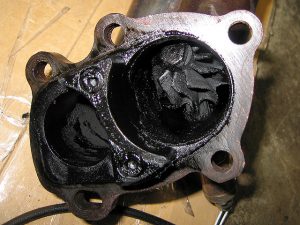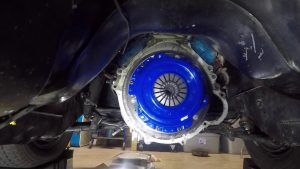Buying a used car is one thing. Buying a used performance car is an additional thing.
You should assume that the car has been run hard. It’s what people buy performance cars for, after all.
But that isn’t the real worry. As a general rule, performance cars are also heavier-duty cars, equipped with stouter engines, high-capacity cooling/oiling systems, upgraded brakes and heavy-duty suspension parts designed to hold up to hard use. The manufacturer also has a vested interest in the car not breaking on account of being used for its intended purpose. If it does, word gets out and people tend to not buy such performance cars when they are new. 
A used performance car can be safer bet on account of this than a used commuter car that was run hard – but not built to take it. People sometimes make the mistake of assuming the used commuter car wasn’t run hard because it wasn’t designed for that. Which, of course, may not be the case. And if it was run hard, the odds of it being a money pit are higher on account of it.
With used performance cars, the fulcrum isn’t whether it was driven hard so much as whether it was maintained well. Specifically, whether there is evidentiary support for it having been maintained well.
Does it come with receipts and such establishing that it has been well-maintained? Ideally, according to the manufacturer’s severe use or heavy-duty service schedule, which recommends more frequent oil and filter changes, cooling system service, brake fluid changes and so on.
This is far more important than superficialities easily identified and corrected such as bald tires or even worn out brakes, which involve the replacement of parts that are routinely replaced.
You want to avoid having to replace things which shouldn’t need replacing, routinely or otherwise.
It is harder to see the inside of an engine – or the transmission – and a look at the dipstick or a check of the fill-hole can be deceptive, if the oil/lube was changed out just prior to the car getting its For Sale sign.
Given the money you’re laying out up front – and the money you could find yourself laying out down the road – it is sound policy to shy away from any prospective used performance car that doesn’t have service documentation, ideally dating back to new.
A prospect that doesn’t have such a paper trail should be assumed to have been poorly maintained and bought only if the price is low enough to compensate for the service you should do as soon as you get it home – as a presumptive palliative – including a complete cooling system service, oil and filter (you should assume the oil in the engine at purchase isn’t the high-quality (and high dollar) synthetic that almost all modern performance cars require), transmission/transaxle and brake service – including a flush of the hydraulic system and refill with the specified brake fluid (as opposed the who-knows-what-it-is fluid in the system at purchase time).
If the car is one of those that requires a timing belt/tensioner check/replacement at a certain mileage and there is no record of it having been done, assume it will need to be done.
Adjust your offer accordingly.
Lubrication and cooling system service are particular agenda items if the car has a turbocharged engine. These run hotter even when not run hard and if they run hotter when run hard than the design spec because the oil wasn’t changed often enough – or the cooling system not flushed/refilled per the schedule – then the life of the turbo – there are sometimes two – might prove to be less than you’d hoped (and budgeted) for.
If the car has more than 70,000 miles on the clock and a manual transmission and there’s no paperwork that the clutch isn’t the original one, assume you’ll be paying for a new one soon – even if the clutch in the car right now doesn’t slip.
Modern cars with slave cylinders/automatically-adjusting clutch take-up often won’t begin to slip until just before they fail. The usual on-the-road test (put it in third or fourth at low speed and floor the gas; if the engine lugs, all is well; if it slips, the clutch is not well) may not tell-tale you that the clutch is 90 percent worn, which it may well be after three or four years of dragstrip launches.
Transmission service is another critical agenda item – whether manual or automatic. Arguably, even more critical if an automatic because automatics are very vulnerable to high heat and old fluid. Even if the specified changeout interval hasn’t been reached, odometer-wise, it’s a very good idea to assume it needs to be changed – even if there isn’t a specified changeout interval. Manufacturers sometimes claim changeouts aren’t necessary for the “lifetime” of the transmission. The catch there is the lifetime of the transmission may be much shorter than the lifetime of the car. Especially if it is a performance car and the transmission was regularly power-braked by its prior owner . . . which you should assume it was.
Having to replace a burnt-out automatic is a big deal. A big expensive deal. Three, four – even five or more thousand dollars. It’s not something to risk on faith.
If the car is an AWD performance car, that system should also be thoroughly vetted as it can be thoroughly expensive to fix.
The bottom line is the things you can’t see can be much more determinative of your future happiness and financial health than the things you can see, such as the tires and brakes and even the struts (and shocks). It is easy to put new tires – and brakes – on a tired ride and thus beguile you into buying in and holding the bag.
Caveat emptor is the rule . . . plus the additional rules.
. . .
Got a question about cars, Libertarian politics – or anything else? Click on the “ask Eric” link and send ’em in!
If you like what you’ve found here please consider supporting EPautos.
We depend on you to keep the wheels turning!
Our donate button is here.
If you prefer not to use PayPal, our mailing address is:
EPautos
721 Hummingbird Lane SE
Copper Hill, VA 24079
PS: Get an EPautos magnet or sticker or coaster in return for a $20 or more one-time donation or a $10 or more monthly recurring donation. (Please be sure to tell us you want a magnet or sticker or coaster – and also, provide an address, so we know where to mail the thing!)
If you’d like an ear tag – custom made! – just ask and it will be delivered.
My latest eBook is also available for your favorite price – free! Click here. If that fails, email me at [email protected] and I will send you a copy directly!












I always prefer a manual transmission when buying a used vehicle. Clutches are inexpensive if you change it yourself.
As others have duly noted, performance cars, especially high dollar performance cars, are indeed babied. What’s more, their owners follow the maintenance schedules religiously and have their rides serviced by top flight experts, whether at the dealers or reputable specialty shops, like Johann’s German Werks. (That was the actual name of a garage near me specializing in German cars.)
I’m actually the most concerned about buying these kinds of cars:
1. The cars owned by “little old ladies from Pasadena.” While they may not have been driven hard, far, or long, the problems with them are caused/aggravated by the cars sitting for long periods. When cars sit, fluids leak, degrade, and evaporate, hoses, belts, seals, and gaskets dry out. What’s more, the miles that they are driven are short trips around town, which doesn’t allow the power train enough time to properly warm up and circulate the fluids, as well as contributing to carbon build up inside the engine. (Newer cars don’t have these problems as much; but my 1968 Oldsmobile, which had only 47,000 original miles, was quite aged by it sitting.)
2. The cars owned by broke/cheap people. For obvious reasons, they often aren’t properly maintained and only serviced when there’s a serious problem. For example, they never change the oil unless it gets low enough to trigger the warning light/gauge, and when they do, they use the cheapest oil they can buy. They also go to garages that are cheap, but have inexperienced/incompetent staff, and make repairs that don’t really fix the problems.
3. The cars owned by, for lack of a better way to say it, suburban soccer parents. The problems with these cars are also a function of money in terms of going cheap on maintenance and service, but also a matter of limited time and tight schedules. For example, they don’t always get the maintenance on schedule because of other things on their schedule, and they also do things like go as far as they can before getting the oil changed. Plus, these cars may very well indeed have been driven hard from rushing from place to place.
Buying a used car entails risk. Such is life. But, and it’s a big butt, so does buying a new car. New does not mean well engineered, or even properly assembled. There are tons of invisible components in new cars, including all the software, and hardware needed to use it, that may or may not be properly programmed past what is necessary to get it off the dealer’s lot. And a used car doesn’t depreciate 5-10 thousand dollars when you drive it away. 5-10 grand will do a lot of work on a car, even on a later model, and more on an older one. In my almost 50 years of driving I’ve bought one new car, because I realized extraordinary profit on a real estate sale. A month later it was a used car. Two years and 50,000 miles later it was out of warranty.
In my experience, most performance cars are actually babied. People rarely drive them anywhere near their design limits. The guy with a Hemi Challenger might do an occasional burnout, but will also change every fluid. Something like a Lancer evolution or Impreza STI being the exception, since most are driven hard by kids.
In my Mercedes dealer days, the AMGs were usually pampered. Talking about bald tires did remind of a C63 that i did a 40k on once. A proper Mercedes service includes a test drive. I always drove them first, so I could look for causes of problems I picked up on during the drive. The C63 had Just over four thousand miles even though it was four years old and due for a 40k service. I got in it and it took off. I just thought to myself that the owner drives it aggressively, because everything was adapted to a very aggressive driving style. I thought “good for him, he drives it like he should” and carried on.
I get it back and in the air, the rear tires are bald, and brakes at about 50% which is unusual at that mileage even on a performance model. The advisor comes out and asks if it needs anything, already assuming the answer is no. I show him the tires and he almost falls back. He says the owner is a feeble old lady, that can barely walk even with a walker. I’m confused, because this car is clearly driven harder than more than 99% of these cars. I finish the service. I happened to be up front when the lady got in her car in the drive. After struggling to put her walker into the trunk, she struggles even harder to make her way to the driver’s seat.
Once in, she starts it, Revs it in park, Puts it in drive and pretty briskly gets it to the exit of the dealership. Once traffic cleared, she gunned it. The tires were spinning, and she was gone in a flash. That was my ultimate, “don’t trust a book by its cover” moments.
There is a reason for this song!
https://www.youtube.com/watch?v=E_6FKsei-oY
I agree, Mattacks. I have a couple friends with late model vettes and one with an 06 GTO. Those cars have thousands of dollars in accessories and goodies, they get polished every 5 minutes, never been abused, and get probably 3 times more maintenance than the factory recommends. I’d buy any one of them in a heartbeat. They’re all probably better than when they came off the assembly line. Then again, all these guys are in their 60’s or early 70’s, maybe that makes a difference.
Glad to see the caveat emptor, Eric.
I bought a 95 T/a vert a few years ago.
I did all my homework, the fluids tested, etc.
A few months ago, it started to overheat. I pulled over.
The ultimate verdict was that the head gaskets were trashed and that meant about 3k in parts and service since I’ve long ago realized my back pain is too serious to work on a car like a 4th gen.
My point is that sometimes you do well, as I have many times, but sometimes you eat a large repair bill like with the 95 even if you do your homework.
Like you said, caveat emptor.
I’ve done well with the advice you provide and sometimes have had to shell out. 80-90’s GM cars tend to give you expensive fits even with low mileage.
But even with a car I paid 5 grand for, then had to put another 3 in 2 years later, I can’t complain. I still have a beautiful black Trans Am convertible and no car payments, plus it doesn’t have all the electronic bugaboos modern cars do.